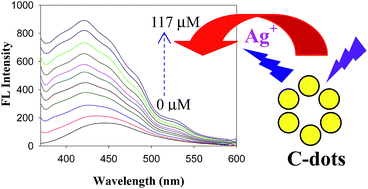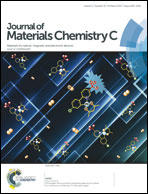One-pot synthesis of carbon nanodots for fluorescence turn-on detection of Ag+ based on the Ag+-induced enhancement of fluorescence†
Abstract
Carbon quantum dots (C-dots) are promising fluorescence probes for applications in metal ion detection, biosensing and bioimaging and so on. In this study, water soluble carbon nanodots were synthesized through a simple one-step heat treatment of ethylene glycol solution. In the present preparation, the C-dots may be formed through the hydration, crosslinking and carbonization processes. The synthesized C-dots show a green luminescent emission under ultraviolet excitation, which can be used for the detection of Ag+ ions. Interestingly, in a different way to the usual quenching effects of metal ions on the fluorescence of C-dots, Ag+ exhibited an enhancement effect on the photoluminescence of C-dots, which can be attributed to the reduction of Ag+ to silver nanoclusters (Ag0) on the surface of the C-dots. Based on the linear relationship between fluorescence intensity and concentration of Ag+ ions, the prepared C-dots can be used for sensitive and selective detection of silver ions in environmental water with a limit of detection of 320 nM and a linear range of 0–90 μM.

- This article is part of the themed collection: JMC C Top Picks collection: The many faces of carbon

 Please wait while we load your content...
Please wait while we load your content...